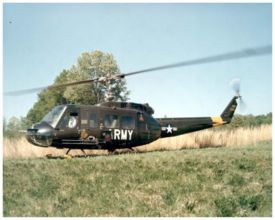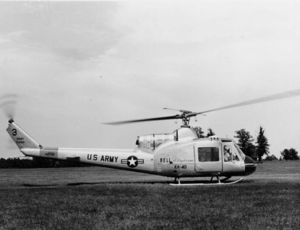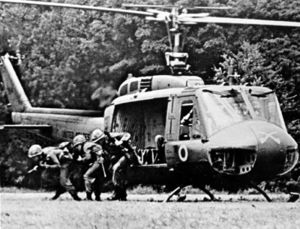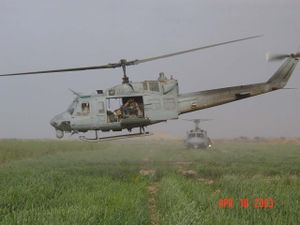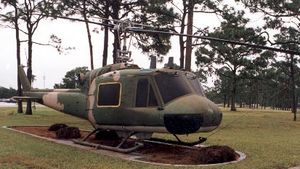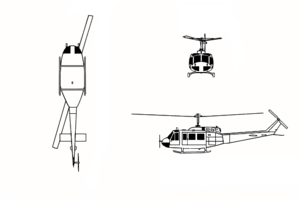PlaneSpottingWorld welcomes all new members! Please gives your ideas at the Terminal.
UH-1
| UH-1 Iroquois | |
|---|---|
| Bell UH-1D Huey of the United States Army | |
| Type | Multipurpose utility helicopter |
| Manufacturer | Bell Helicopter Textron |
| Maiden flight | 22 October 1956 (XH-40) |
| Primary users | United States Army Japan Ground Self-Defense Force Australian Army Armed Forces of the Philippines |
| Number built | >16,000 |
| Variants | UH-1N Twin Huey AH-1 Cobra Bell 204/205 Bell 212 Bell 214 |
The Bell Helicopter Textron UH-1 Iroquois, commonly (or officially in the United States Marine Corps) known as the "Huey", is a multipurpose military helicopter, famous for its use in the Vietnam War. The "U" stands for utility, in contrast to attack or cargo helicopters.
The UH-1 was developed from 1955 US Army trials with the Bell Model 204. The initial designation of HU-1 (helicopter utility) led to its nickname, Huey. It was first used by the military in 1959 and went into tri-service production in 1962 as the UH-1. The last were produced in 1976 with more than 16,000 made in total,[1] of which about 7,000 saw use during the Vietnam War.
In Vietnam, 2,202 Huey pilots were killed and approximately 2,500 aircraft were lost, roughly half to combat and the rest to operational accidents.
Contents
Development
Earlier helicopters had been powered by piston engines. By the early 1950s, however, turbine engines were being used in many fixed-wing aircraft and aircraft designers began to consider using them for rotary-wing use. Turbines, though expensive to build, were long-lived, durable, and extremely light for their power output in comparison to piston-powered engines.
XH-40 and YH-40
The first Bell helicopter to use a turbine engine was a modified Model 47 (designated the XH-13F), first flown in October 1954. In 1955, anxious to obtain a powerful medical evacuation helicopter, the U.S. Army awarded Bell a contract to develop the next generation turbine-powered helicopter, designated the XH-40 (Bell company designation was the Model 204). The first XH-40 flew on 22 October 1956. Two more prototypes were built in 1957, and six YH-40 prototypes were tested in 1958.
Bell believed the YH-40 was ideal for troop transport and cargo carrying as well as the medevac role, a view soon adopted by the Army, who found the pre-production aircraft so much better in service than previous piston-powered helicopters they soon ordered more of them.
UH-1A
The HU-1A (later redesignated the UH-1A) was the first turbine-equipped U.S. helicopter to go into production, and production models first entered service with the 101st Airborne Division at Fort Lewis, Washington, the 82nd Airborne Division and the 57th Medical Detachment. Although they were intended for evaluation only, the Army quickly pressed them into operational service and Hueys with the 57th Medical Detachment arrived in Vietnam in March 1962.[2]
The helicopter was originally designated the HU-1A, which is where it received its nickname - "Huey." The official U.S. Army designation Iroquois (Army helicopters are traditionally given Native American names) was almost never used in practice.[3]
Fourteen of the original order of UH-1As were designated as TH-1A which were used for crew training and a single aircraft was redesignated XH-1A for grenade launcher testing in 1960.[2]
The first UH-1As to arrive in Vietnam after the 57th Medical Detachment were with a new test unit, the US Army's Utility Tactical Transport Company (UTTCO). UTTCO had 20 "Alpha" Hueys and deployed to Vietnam in the fall of 1962.[4] These aircraft were used as armed escorts to the existing H-21 Shawnees and H-34 Choctaws troop carriers.[3][2]
In use the UH-1A proved under-powered with their Lycoming T53-L-1 powerplants of just 860 shp and indicated the need for improved follow-on models of the Huey.[3][2]
UH-1B
The HU-1B was an improved model that was equipped with the Lycoming T53-L-5 engine of 960 shp, revised main rotor blades of 44 foot diameter and 21 inch chord, 13 inch higher rotor mast and a longer cabin that could accommodate seven passengers.[3][2] This version was redesignated UH-1B in 1962.
Later production UH-1Bs were equipped with Lycoming T53-L-9 and L-11 engines of 1100 shp. Gross weight was 8,500 lbs and the standard empty weight was 4513 lbs.[3][2]
Army testing of the "B" model started in November, 1960 with first production aircraft arriving in March, 1961. A total of 1010 "Bravo" models were delivered to the US Army. First deployment was in November 1963 when eleven were sent to Vietnam to join the "Alpha" models already in use by UTTCO.[2]
One NUH-1B was produced for test purposes.[2]
Bell certified a civil version of the UH-1B incorporating some minor safety improvements, such as improved door locks. The aircraft was marketed as the Bell 204B.[2]
UH-1C
The UH-1C was specifically developed as a gunship version until the "interim" attack helicopter, the Bell AH-1G Huey Cobra was available and to correct the deficiencies of the UH-1B when it was used in the armed role. The UH-1C was widely referred to as the "Huey Hog" in US Army service.[3][2]
The "Charlie" model was fitted with the 1100 shp T53-L-9 or L-11 engine to provide the power needed to lift the weapons systems in use or under development at the time. It incorporated the new Bell 540 rotor system with 27 inch chord blades. The increased power lead Bell's engineers to design a new tailboom for the "C" which incorporated a wider chord fin on a longer boom and larger synchronized elevators. The "C" also introduced a dual hydraulic control system for redundancy in battle and an improved inlet filter system for the dusty conditions found in southeast Asia. Fuel was increased to 242 US gallons and gross weight to 9500 lbs, giving a nominal useful load of 4673 lbs.[3][2]
Development on the "C" model had commenced in 1960, with production starting in June 1966. A total of 766 "C" models was completed, including five for the Royal Australian Navy, designated N9 and five for Norway. The balance went to the US Army.[3][2]
Many UH-1Cs were later re-engined with the 1400 shp Lycoming T53-L-13 powerplant. With this engine they were redesignated UH-1M.[3][2]
UH-1D
The earlier "short-body" Hueys were a success, especially in the gunship role, but lacked the cabin space to be an effective troop transport. The US Army wanted a version that could carry a crew of four (two pilots and two door gunners) and also deliver an infantry section of eight-ten soldiers. Bell's solution was to stretch the UH-1B fuselage by 41 inches (105 cm) and use the extra space to fit two sideways-facing seats on either side of the transmission. This brought the total seating capacity to 15, including crew seats.[3][2]
The new Huey was designated UH-1D by the US Army and as the Model 205 by Bell. The enlarged cabin could also accommodate six stretchers, double that of the earlier models, making the "Delta" a good MEDEVAC aircraft. In place of the earlier model's sliding side doors with a single window, larger doors were fitted which had two windows, plus a small "hinged panel" with an optional window, providing access to the cabin. The doors and hinged panels were quickly removable and the Huey could be flown in that configuration.[2]
The first YUH-1D prototype flew in August 1960. Seven YUH-1Ds were delivered and tested at Edwards AFB starting in March 1961. The YUH-1D was initially equipped with a 44 ft main rotor and a Lycoming T53-L-9 engine. Testing revealed that more power was required and so the rotor was lengthened to 48 ft with a chord of 21 inches and the engine was upgraded to the Lycoming T53-L-11 engine of 1,100 shp. A longer tailboom was designed to accommodate the longer rotor blades. Gross weight was 9,500 lbs. Later production "Deltas" had the Lycoming T53-L-13 powerplant of 1,400 shp installed.[3][2]
The first Army unit deliveries of the "Delta" model were on 9 August 1963 when the 11th Air Assault Division (Test) at Fort Benning Georgia received two. This unit was renamed the 1st Cavalry Division and deployed to Vietnam with its "Delta" Hueys.[3][2]
A total of 2008 UH-1Ds were delivered to the US Army between 1962 and 1966. The model was widely exported and served with the armed forces of Australia and South Vietnam among others. A grand total of 2,561 UH-1Ds were built, including 352 constructed by Dornier for the West German armed forces.[3][2]
The HH-1D was a base rescue/fire-fighting version for the US Army that had a 50 gallon water and foam spray system that could be discharged via an extendable 16 foot boom.[2]
Upgrading the UH-1D to the Lycoming T53-L-13 engine, plus relocating the pitot tube from the nose to the roof resulted in a new model, the UH-1H, which was to become the most produced variant of the Huey family.[3][2]
UH-1E
In 1962 the US Marines held a competition to choose a new assault support helicopter to replace the Cessna O-1 and Kaman OH-43D helicopter. The winner was the UH-1B which was already then in service with the US Army.[3]
The UH-1B was developed into a special model, designated UH-1E, to meet Marine Corps requirements. The major changes included the use of all-aluminum construction for corrosion resistance (earlier UH-1s had some magnesium components), special avionics that were compatible with Marine Corps ground frequencies, a rotor brake to stop the rotor quickly on shutdown for shipboard use and a roof-mounted rescue hoist.[3][2]
The UH-1E was first flown on 7 October 1963 and deliveries commenced 21 February 1964, with 192 aircraft completed. Due to production line realities at Bell the UH-1E was produced in two different versions, both with the same UH-1E designation. The first 34 built were essentially UH-1B airframes with the Lycoming T53-L-11 of 1,100 shp. Because Bell was switching Army production to the UH-1C the UH-1E production line was converted to commonality with the “C”. This meant the later “Echo” Hueys were completed with the “Charlie” style tailboom including the larger fin, the 540 rotor system and a gross weight of 8,500 lbs.[2]
The Marines used the UH-1E as both a gunship and troop transport. Many were upgraded to the Lycoming T53-L-13 engine which produced 1,400 shp, making these “Echos” similar to the Army “Mike” models. At least 126 UH-1Es survived their Vietnam service and were still in use more than a decade later.[3][2]
There was a Marine Corps training version of the UH-1E, which was based on the UH-1C variant and was designated TH-1E. Twenty were delivered in 1965.[2]
UH-1F
Bell Helicopters was the winner of a 1963 United States Air Force competition for a support helicopter for use on its missile bases.[2]
Bell had proposed the UH-1B for the competition but the USAF asked Bell to develop a special version of the "Bravo" in using the General Electric T58 turboshaft as a powerplant. The USAF already had a large inventory of these engines for its fleet of Sikorsky HH-3 Jolly Green Giant rescue helicopters and wanted to have commonality between the types. This engine was capable of 1,250 hp (932 kW) compared to the UH-1B's 1,100 hp (820 kW) Lycoming T53-L11.[2][3]
In response Bell proposed an upgraded version of the UH-1B with the T58 engine installed. The resulting UH-1F had the shorter cabin of the "Bravo" Huey, but with the longer tail boom, rotor and transmission of the UH-1D.[2]
Due to the Huey's configuration, Bell installed the T58 engine backwards compared to the HH-3. The Huey's engine is behind the transmission, whereas the HH-3's engines are in front of the transmission. Externally, the only visible differences from UH-1B were the engine exhaust, which exited to the right side of the engine and the longer tail boom.[2]
The UH-1F was introduced into the USAF inventory on 20 February 1964. The USAF took delivery of 119 with production ending in 1967. Many of the aircraft served in southeast Asia with the 20th Special Operations Squadron and some were converted to the armed UH-1P configuration.[2][3]
In Italy, Agusta produced a similar model by re-engining the 204B with the 1,225 hp (914 kW) Rolls-Royce Gnome turboshaft and later the UH-1F's General Electric engine. The Italian version was exported to the military of the Netherlands, Denmark, Austria, and Switzerland. It had a rescue hoist located at the right side of the cabin.
The last UH-1F was retired from the USAF in the early 1980s when it was replaced by the UH-1N. many of these aircraft later served as forest fire fighting aircraft with various US state governments and agencies.[2]
There was a TH-1F trainer also built for the USAF. The first TH-1F was flown in January 1967 and deliveries ran from April to July of that year with 27 completed.[2]
UH-1H
The UH-1H was an improved UH-1D, with the Lycoming T53-L-13 engine of 1,400 shp installed, plus the pitot tube relocated from the nose to the roof, to reduce ground damage to it. "Hotel" models were created by upgrading "Deltas" as well as new production. The first YUH-1H flew in 1966 with deliveries of production models starting in September 1967.[3][2]
The "Hotel" model Huey was produced in larger numbers than any other model, with 4,850 delivered to the US Army alone.[3] The "Hotel" model was widely exported and was also built under licence in Germany, Italy, Japan and Taiwan.[2]
Ten were sold to Canada for use under the designation CUH-1H with the first one was delivered on 6 March 1968. These were evaluated by the Canadian Forces and found unsuitable for Canadian tactical use, which resulted in the Canadian government sponsoring the development of the twin-engined version of the "Hotel", the UH-1N Twin Huey. The ten CUH-1Hs were re-equipped for search and rescue use, redesignated CH-118 and served until 1995.[3][2]
The "Hotel" model Huey was also the basis for a number of sub-variants:
- HH-1H was a UH-1H equipped for base rescue duties. Thirty were delivered to the USAF between 1970-73.[3][2]
- EH-1H was a UH-1H modified under Project Quick Fix in 1976 and used as communications jamming aircraft with the US Army. Twenty-two aircraft were modified to this configuration beginning in 1976. Initial aircraft were fielded to the 82nd Airborne Division and the 2nd Armored Division. The 82nd fielded the type during the invasion of Grenada (Operation Urgent Fury) in 1983.[3][2]
- EH-1X was an improved EH-1H communications jammer and DF aircraft.[2]
- JUH-1 was a UH-1H equipped with retractable skid gear and an AN/APS 94 radar boom mounted on the belly.[2]
- UH-1V was a MEDEVAC version of the "Hotel", with upgraded avionics.[2]
- TH-1H: Modified UH-1Hs for use as basic helicopter flight trainers by the USAF.
Bell developed a certified version of the UH-1H for the civil market. The aircraft incorporated minor changes for safety, such as dual sliding door locks and a baggage compartment in the tailboom. It was marketed by Bell as the Model 205A and later the improved 205A-1.[2]
HH-1K
Bell was awarded a contract by the US Navy in December 1968 for a new search and rescue helicopter. The aircraft was designated the HH-1K and was basically a UH-1E with different avionics and the Lycoming T53-L-13 powerplant of 1,400 shp.[3][2]
Deliveries of the “Kilo” Huey started in May 1970 and by November of that year three had been sent to Vietnam to serve with US Navy squadron HA(L)-3. A total of 27 HH-1Ks were produced.[2]
UH-1L
With deliveries of the UH-1E underway to the US Marines the US Navy tested a few and found that the type would suit their uses as a utility helicopter. On 16 May 1968, the US Navy ordered eight aircraft under the designation UH-1L.[3][2]
The “Lima” Huey was basically a UH-1E, of the later production type based on the Army's UH-1C, equipped with a rescue hoist and intake particle screen. The “Ls” were delivered without the armour or armament installed and were equipped with the Lycoming T53-L-13 powerplant of 1,400 shp.[3][2]
The first four “Limas” were delivered in November 1969 and sent to Vietnam to equip the US Navy HA(L)-3 detachment assigned to Operation Sealords. In Vietnam the aircraft were modified with weapons and armour and were fitted to carry 500 lb bombs and 500 lb Fuel-Air Explosive munitions.[2]
There was a TH-1L version of the UH-1L for the Navy to replace the H-34 and the borrowed Army UH-1Ds used in the training role, including for pilot aircraft carrier qualification training. Forty-five TH-1Ls were delivered starting in November 1969.[2]
UH-1M
The "Mike" model Huey was a conversion of the existing UH-1C by re-engining it with the 1,400 shp Lycoming T53-L-13 powerplant used in the UH-1H. This provided more power to the "C" model for its role as a gunship and also provided engine commonality between the attack and transport helicopters in use in Vietnam at that time.[3][2]
UH-1N
Bell flew the first twin-engined Huey in April 1965, calling it the Model 208. It was powered by two Continental Motors engines. The Canadian government provided the incentive for Bell to continue development of the Twin Huey using Pratt & Whitney Canada PT6 engines. The project attracted orders from the Canadian Forces, US Marine Corps, US Navy and USAF, but not the US Army.[3][2]
The new aircraft was designated UH-1N Iroquois in US service and CUH-1N Twin Huey in Canadian Forces use. The Canadian designation was later changed to CH-135 Twin Huey. There was an HH-1N version produced for the USAF as a base rescue helicopter and for use by the 20th Special Operations Squadron in the counter-insurgency role using the call sign Green Hornet. Some Marine Corps UH-1Ns were converted to VH-1Ns as VIP transports, including six for Presidential use.[3][2]
The UH-1N was widely produced and exported to a large number of countries and licence-built by Agusta in Italy and the People's Republic of China. Bell certified a civil version as the Model 212 in October 1970.[3]
UH-1P
An unknown number of UH-1Fs were modified to UH-1P configuration by the USAF for use by the their 20th Special Operations Squadron, The Green Hornets, based in southeast Asia during the Vietnam War.[2][3]
Official USAF sources state that these aircraft were used for a classified psychological warfare role, but this is incorrect. The "Papa" Hueys were in fact modified and employed as gunships armed with machine guns and rocket launchers.[2]
UH-1V
The UH-1V is a version of the UH-1H converted by the US Army Electronics Command for MEDEVAC use. The aircraft have several upgrades including a radar altimeter, DME, ILS and a rescue hoist. The first aircraft were supplied to the New Hampshire National Guard.[2]
EH-1X
The EH-1X was an improved EH-1H that was equipped with the AN/ALQ-151 system and configured for the airborne jamming, radio intercept and DF role. Ten EH-1Xs were built starting in late 1976 under Project Quick Fix IIA.[2]
UH-1Y
The UH-1Y Venom is an upgraded UH-1N Twin Huey for the US Marines that was first flown on November 18 2006.
JUH-1 SOTAS
The JUH-1 was a modified UH-1H an AN/APS 94 radar system mounted in a rotating boom on the belly, where the cargo hook had been. The aircraft's skid landing gear was modified to retract allowing the radar antennae to rotate while in flight. The JUH-1s also incorporated an autopilot and improved navigation avionics. The radar system was connected by datalink to a ground station for analysis of the radar images.[2]
At least four UH-1Hs were modified to JUH-1s for use by the US Army in Europe and Korea for use as technology demonstrators in the Stand Off Target Acquisition System (SOTAS) program. They were first deployed in 1975 but by 1986 they had been replaced by the EH-60 Black Hawk.[2]
Operational history
Service in Vietnam
The UH-1 has long become a symbol of US involvement in Southeast Asia in general and Vietnam in particular, and as a result of that conflict, has become one of the world's most recognized helicopters. In Vietnam primary missions included general support, air assault, cargo transport, aeromedical evacuation, search and rescue, electronic warfare, and later, ground attack. During the conflict, the craft was upgraded, notably to a larger version based on the Model 205. This version was initially designated the UH-1D and flew operationally from 1963.
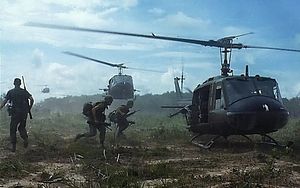
During service in the Vietnam War, the UH-1 was used for various purposes and various terms for each task abounded. UH-1s tasked with a ground attack or armed escort role were outfitted with rocket launchers, grenade launchers, and machine guns. These gunship UH-1s were commonly referred to as Hogs if they carried rockets, and Cobras if they had guns.[5] While UH-1s tasked for troop transport were often called Slicks due to an absence of weapons pods. Slicks did have door gunners, but for the most part they were strictly troop carriers and medevacs.[3][2] In the US Navy and USMC the difference between gunships were referred to as Sharks, troop transport aircraft, Dolphins.
UH-1s also flew hunter-killer teams with observation helicopters, namely the Bell OH-58A Kiowa and the Hughes OH-6 Cayuse (Loach).[3][2]
Towards the end of the conflict, the UH-1 was tested with TOW missiles, and two UH-1B helicopters equipped with the XM26 Armament Subsystem were deployed to help counter the 1972 Easter Invasion.[6] USAF Lieutenant James P. Fleming piloted a UH-1F on a 26 November 1968 mission that won him the Medal of Honor.
UH-1 troop transports were designated by Blue teams, hence the nickname for troops carried in by these Hueys as the Blues. The reconnaissance or observation teams were White teams. The attack ships were called Red teams. Over the duration of the conflict the tactics used by the military evolved and teams were mixed for more effective results. Purple teams with one or two Blue slicks dropping off the troops, while a Red attack team provided protection until the troops could defend themselves. Another highly effective team was the Pink Recon/Attack team, which offered the capability of carrying out assaults upon areas where the enemy was known to be present but could not be pinpointed.[3]
During the course of the War, the UH-1 went through several upgrades. The UH-1A, B, and C models (short fuselage, Bell 204) and the UH-1D and H models (stretched-fuselage, Bell 205) each had improved performance and load-carrying capabilities. The UH-1B and C performed the gunship and some of the transport duties until 1967, when the new AH-1 Cobra arrived on the scene. The newer Cobra, a purpose-built attack helicopter based on the UH-1 was faster, sleeker, harder to hit, and could carry more ordinance. The increasing intensity and sophistication of NVA anti-aircraft defenses made continued use of gunships based on the UH-1 impractical, and after Vietnam the Cobra was adopted as the Army's main attack helicopter. Devotees of the UH-1 in the gunship role cite its ability to act as an impromptu dustoff if the need arose, as well as the superior observational capabilities of the larger Huey cockpit, which allowed return fire from door gunners to the rear and sides of the aircraft.[3][2]
During the war 3,305 UH-1 were destroyed. In total, 5,086 helicopters were destroyed out of 11,827 documented in service.[7]
USAF
In October 1965, the USAF 20th Special Operations Squadron was formed at Tan Son Nhut Air Base in South Vietnam, equipped initially with CH-3C helicopters. By June 1967 the UH-1F and UH-1P were also added to the unit's inventory, and by the end of the year the entire unit had shifted from Tan Son Nhut to Nakhon Phanom Royal Thai Air Force Base. On 1 August 1968, the unit was redesignated the 20th Special Operations Squadron. The 20th's UH-1s were known as the "Green Hornets", stemming from their color, a primarily green two-tone camouflage (green and tan) was carried, and radio call-sign "hornet". The main role of these helicopters were to insert and extract reconnaissance teams, provide cover for such operations, conduct psychological warfare, and other support roles for covert operations especially in Laos during the so-called Secret War.
Nahr el Bared battle in Lebanon
During the battle of Nahr el-Bared camp in North Lebanon, the Lebanese army, lacking fixed-wing aircraft, modified the UH-1H allowing it to carry 400 lb (250 kg) Mk. 82 dumb bombs to strike militant positions. Each Huey was equipped on each side with special mounts engineered by the Lebanese army, to carry the high explosive bombs. (See: Helicopter bombing).
Current service
The US Army phased out the UH-1 Huey with the introduction of the UH-60 Black Hawk, although the Army UH-1 Residual Fleet has around 700 UH-1s that were supposed to be retained until 2015. Army support for the craft was intended to end in 2004.[citation needed]
The US Marine Corps still relies on the UH-1N variant and is beginning to introduce the latest variant, the UH-1Y Venom.
The United States Air Force employs Hueys to fulfill its ICBM mission, providing a utility helicopter for transport between bases such as Francis E. Warren AFB and Malmstrom AFB to missile launch sites in Montana, Wyoming, Nebraska, and Colorado.
The UH-1 has been widely exported and remains in front-line service in a number of countries.
Design
Aircraft markings
UH-1Hs used for ferrying VIPs into Panmunjom in the DMZ area between North and South Korea used three 12" wide Yellow stripes vertically over the fuselage. It signified unarmed aircraft carrying UNCMAC members.[8]
U.S. Navy UH-1Ns serving as "organic to the ship" helicopters on LPH and LHA amphibious war vessels were painted dark grey with national insignia, much like the paint scheme carried on the Kaman SH-2 Seasprite throughout the 1980s. Each ship had one helicopter, and the ship's name was often carried on the cabin doors.[citation needed]
Variant overview
U.S. Military variants
- XH-40: The initial Bell 204 prototype. Three prototypes were built, equipped with the Lycoming XT-53-L-1 engine of 700 shp.[2]
- YH-40: Six aircraft for evaluation, as XH-40 with 12-inch cabin stretch and other modifications.
- Bell Model 533: One YH-40BF rebuilt as a flight test bed with turbofan engines and wings.
- HU-1A: Initial Bell 204 production model, redesignated as the UH-1A in 1962.[2] 182 built.[9]
- HU-1B: Upgraded HU-1A, various external and rotor improvements. Redesignated UH-1B in 1962.[2] 1014 built plus four prototypes designated YUH-1B. [9]
- NUH-1B: a single test aircraft, serial number 64-18261.[2]
- UH-1C: UH-1B with improved engine, modified blades and rotor-head for better performance in the gunship role.[2] 767 built.[9]
- YUH-1D: Seven pre-production prototypes of the UH-1D.
- UH-1D: Initial Bell 205 production model (long fuselage version of the 204). Designed as a troop carrier to replace the CH-34 then in US Army service.[2] 2008 built many later converted to UH-1H standard. [9]
- HH-1D: Army crash rescue variant of UH-1D.[2]
- UH-1E: UH-1B/C for USMC with different avionics and equipment.[2] 192 built.[9]
- NUH-1E: UH-1E configured for testing.
- TH-1E: UH-1C configured for Marine Corps training. Twenty were built in 1965.[2]
- UH-1F: UH-1B/C for USAF with General Electric T-58-GE-3 engine of 1,325 shp.[2]. 120 built.[9]
- UH-1G: UH-1D/H gunships operating with the Cambodia armed forces were locally given the designation UH-1G.[citation needed]
- UH-1H: Improved UH-1D with a Lycoming T-53-L-13 engine of 1,400 shp.[2] 5435 built.[9]
- CUH-1H: Canadian Forces designation for the UH-1H utility transport helicopter. Redesignated CH-118.[10][2] 10 built.[9]
- EH-1H: Twenty-two aircraft converted by installation of AN/ARQ-33 radio intercept and jamming equipment for Project Quick Fix.
- HH-1H: SAR variant for the USAF with rescue hoist.[2]30 built.[9]
- JUH-1: Five UH-1Hs converted to SOTAS battlefield surveillance configuration with belly-mounted airborne radar.[2]
- TH-1H: Recently modified UH-1Hs for use as basic helicopter flight trainers by the USAF.
- UH-1J: An improved Japanese version of the UH-1H built under license in Japan by Fuji was locally given the designation UH-1J.[11] Among improvements were an Allison T53-L-703 turboshaft engine providing 1,343 kW (1,800 shp), a vibration-reduction system, infrared countermeasures, and a night-vision-goggle (NVG) compatible cockpit.[12]
- HH-1K: Purpose built SAR variant of the Model 204 for the US Navy with USN avionics and equipment.[2] 27 built.[9]
- TH-1L: Helicopter flight trainer based on the HH-1K for the USN. Forty-five were built.[2]
- UH-1L: Utility variant of the TH-1L. Eight were built.[2]
- UH-1M: Gunship specific UH-1C upgrade with Lycoming T-53-L-13 engine of 1,400 shp.[2]
- UH-1N: Initial Bell 212 production model, the Bell "Twin Pac" twin-engined Huey.[2]
- UH-1P: UH-1F variant for USAF for special operations use and attack operations used solely by the USAF 20th Special Operations Squadron, "the Green Hornets".[2]
- UH-1U: Single prototype for Counter Mortar/Counter Battery Radar Jamming aircraft. Crashed at Edwards AFB during testing.[citation needed]
- UH-1V: Aeromedical evacuation, rescue version for the US Army.[2]
- EH-1X: Ten Electronic warfare UH-1Hs converted by under "Quick Fix IIA".[2]
- UH-1Y: Upgraded variant developed from existing upgraded late model UH-1Ns, with additional emphasis on commonality with the AH-1Z.
- UH-1/T700 Ultra Huey: Upgraded commercial version, fitted with a 1,400-kW (1900-shp) General Electric T700-GE-701C turboshaft engine.
Note: In U.S. service the G, J, Q, R, S, T, W and Z model designations are used by the AH-1. The UH-1 and AH-1 are considered members of the same H-1 series. The military does not use I (India) or O (Oscar) for aircraft designations to avoid confusion with "one" and "zero" respectively.
Other military variants
- Bell 204: Bell Helicopters company designation, covering aircraft from the XH-40, YH-40 prototypes to the UH-1A, UH-1B, UH-1C, UH-1E, UH-1F, HH-1K, UH-1L, UH-1P and UH-1M production aircraft.
- Agusta-Bell AB 204: Military utility transport helicopter. Built under license in Italy by Agusta.
- Agusta-Bell AB 204AS: Anti-submarine warfare, anti-shipping version of the AB 204 helicopter.
- Fuji-Bell 204B-2: Military utility transport helicopter. Built under license in Japan by Fuji Heavy Industries. Used by the Japan Ground Self-Defense Force under the name Hiyodori.
- Bell 205: Bell Helicopters company designation of the UH-1D and UH-1H helicopters.
- Bell 205A-1: Military utility transport helicopter version, initial version based on the UH-1H.
- Bell 205A-1A: As 205A-1, but with armament hardpoints and military avionics. Produced specifically for Israeli contract.
- Agusta-Bell 205: Military utility transport helicopter. Built under license in Italy by Agusta.
- AIDC UH-1H: Military utility transport helicopter. Built under license in Taiwan by Aerospace Industrial Development Corporation.[13]
- Dornier UH-1D: Military utility transport helicopter. Built under license in Germany by Dornier Flugzeugwerke.[13]
- Fuji-Bell 205A-1: Military utility transport helicopter. Built under licence in Japan by Fuji. Used by the Japanese Ground Self Defence Force under the designation HU-1H.[14]
- Bell Huey II: A modified and re-engined UH-1H, significantly upgrading its performance, and its cost-effectiveness. Currently offered by Bell to all current military users of the type.
Operators
Survivors
The UH-1 experienced a production number in the thousands (both short and long-frame types), and invariably a large number exist in flyable condition in nations around the world. A large number of decommissioned and retired aircraft exist as "gate guards" to various military bases, in aviation museums, and other static-display sites. Examples include:
- The Bell UH-1H "Smokey III" that resides in the Steven F. Udvar-Hazy Center served four tours and over 2,500 hours in Vietnam.
- UH-1A located at the Intrepid Sea-Air-Space Museum in New York City, currently under refurbishment.
- A Huey forms part of the collection in the American Air Force Hangar of the Imperial War Museum at Duxford near Cambridge, England.
Specifications (UH-1D)
General characteristics
- Crew: 1-4
- Capacity: 3,880 lb including 14 troops, or 6 stretchers, or equivalent cargo
- Length: 57 ft 1 in with rotors (17.4 m)
- Rotor diameter: 48 ft 0 in (14.6 m)
- Height: 14 ft 5 in (4.4 m)
- Empty weight: 5,215 lb (2,365 kg)
- Loaded weight: 9,040 lb (4,100 kg)
- Max takeoff weight: 9,500 lb (4,310 kg)
- Powerplant: 1× Lycoming T53-L-13B turboshaft, 1,400 shp (1,045 kW)
- Maximum speed: 135 mph (220 km/h)
- Cruise speed: 125 mph (205 km/h)
- Range: 315 mi (510 km)
- Service ceiling: 19,390 ft (Dependent on environmental factors such as weight, outside temp., etc) (5,910 m)
- Rate of climb: 1,755 ft/min (8.9 m/s)
- Power/mass: 0.15 hp/lb (0.25 kW/kg)
Variable, but may include a combination of:
- 2x 7.62 mm M60 machine gun, or 2x 7.62 mm GAU-17/A machine gun
- 2x 7-round or 19-round 2.75 in (70 mm) rocket pods
For information on US armament systems see:
Popular culture
The image of American troops disembarking from a Huey has become a fixture in depictions of the Vietnam War, and can be seen in practically every movie, video game and television show on the subject, as well as more modern settings.[citation needed]. Author Robert Mason recounts his career as a UH-1 "Slick" pilot in his memoir, Chickenhawk. The UH-1 is seen in almost every Vietnam war movie, including Platoon, Hamburger Hill, Apocalypse Now, Casualties of War, and Born on the Fourth of July. It is most prominently featured in We Were Soldiers as the main helicopter used by the U.S. cavalry in the Battle of the Ia Drang Valley.
See also
Related development
- AH-1 Cobra
- AH-1 SuperCobra
- UH-1N Twin Huey
- UH-1Y Venom
- Bell 204/205
- Bell 212
- Bell 214
- Bell 412
- Bell 533
- Panha Shabaviz 2-75
Comparable aircraft
Designation sequence
Related lists
See also
Lists relating to aviation | |
|---|---|
| General | Timeline of aviation · Aircraft · Aircraft manufacturers · Aircraft engines · Aircraft engine manufacturers · Airports · Airlines |
| Military | Air forces · Aircraft weapons · Missiles · Unmanned aerial vehicles (UAVs) · Experimental aircraft |
| Notable incidents and accidents | Military aviation · Airliners · General aviation · Famous aviation-related deaths |
| Records | Flight airspeed record · Flight distance record · Flight altitude record · Flight endurance record · Most produced aircraft |
References
Notes
- ↑ Bell Helicopter UH-1 web site
- ↑ 2.00 2.01 2.02 2.03 2.04 2.05 2.06 2.07 2.08 2.09 2.10 2.11 2.12 2.13 2.14 2.15 2.16 2.17 2.18 2.19 2.20 2.21 2.22 2.23 2.24 2.25 2.26 2.27 2.28 2.29 2.30 2.31 2.32 2.33 2.34 2.35 2.36 2.37 2.38 2.39 2.40 2.41 2.42 2.43 2.44 2.45 2.46 2.47 2.48 2.49 2.50 2.51 2.52 2.53 2.54 2.55 2.56 2.57 2.58 2.59 2.60 2.61 2.62 2.63 2.64 2.65 2.66 2.67 2.68 2.69 2.70 2.71 2.72 2.73 2.74 2.75 2.76 2.77 2.78 2.79 2.80 2.81 Mutza 1986
- ↑ 3.00 3.01 3.02 3.03 3.04 3.05 3.06 3.07 3.08 3.09 3.10 3.11 3.12 3.13 3.14 3.15 3.16 3.17 3.18 3.19 3.20 3.21 3.22 3.23 3.24 3.25 3.26 3.27 3.28 3.29 3.30 3.31 3.32 3.33 3.34 3.35 Drendel 1983, p. 9-21.
- ↑ Guilmartin and O'Leary 1988, p. 31.
- ↑ Bishop, Chris. Huey Cobra Gunships. London: Osprey Publishing, 2006. ISBN 1-84176-984-3.
- ↑ U.S. Army Helicopter Weapon Systems: Operations with XM26 TOW missile system in Kontum (1972)
- ↑ "Helicopter Losses During the Vietnam War." Vietnam Helicopter Pilots Association. Retrieved: 5 September 2007.
- ↑ Reg 551-4
- ↑ 9.00 9.01 9.02 9.03 9.04 9.05 9.06 9.07 9.08 9.09 9.10 9.11 Andrade 1987, p. 125. Cite error: Invalid
<ref>tag; name "Andrade p 125" defined multiple times with different content - ↑ "Bell CH-118 Iroquois." Canadian DND webpage. Retrieved: 30 August 2007.
- ↑ UH-1J 多用途ヘリコプター. Retrieved: 11 December 2007.
- ↑ The Bell UH-1 Huey. Retrieved: 12 December 2007.
- ↑ 13.0 13.1 The Bell UH-1 Huey.
- ↑ ベルUH-1B/Hイロコイ,富士UH-1J『ひよどり』. Retrieved: 11 December 2007.
Bibliography
- Andrade, John M. U.S. Military Aircraft Designations and Serials since 1909. Midland Counties Publications, England, 1979. ISBN 0-904597-22-9.
- Chant, Christopher. Fighting Helicopters of the 20th Century (20th Century Military Series). Christchurch, Dorset, UK: Graham Beehag Books, 1996. ISBN 1-85501-808-X.
- Debay, Yves. Combat Helicopters. Paris: Histoire & Collections, 1996. ISBN 2-90818-252-1.
- Drendel, Lou. Huey., Carrollton, TX: Squadron/Signal Publications,1983. ISBN 0-89747-145-8.
- Francillon, René, J. Vietnam: The War in the Air. New York: Arch Cape Press, 1987. ISBN 0-51762-976-3.
- Guilmartin, John Francis and O'Leary, Michael. The Illustrated History of the Vietnam War, Volume 11: Helicopters. New York: Bantam Books, 1988. ISBN 0-553-34506-0.
- Mesko, Jim. Airmobile: The Helicopter War in Vietnam. Carroltton, TX: Squadron/Signal Publications, 1984. ISBN 0-89747-159-8.
- Mikesh, Robert C. Flying Dragons: The South Vietnamese Air Force. London: Osprey Publishing, 1988. ISBN 0-85045-819-6.
- Mutza, Wayne: UH-1 Huey In Action Squadron/Signal Publications, Carrollton TX USA 1986. ISBN 0-89747-179-2
- Mutza, Wayne. UH-1 Huey in Color. Carroltton, TX: Squadron/Signal Publications, 1992. ISBN 0-89747-279-9.
- Specifications for 204, 205 and 214 Huey Plus
External links
- Official Huey II page on BellHelicopter.com
- UH-1N USAF fact sheet
- UH-1D/UH-1H Iroquois utility helicopter and UH-1 Factsheet on Army.mil
- UH-1 history on Navy Air web site
- The Bell UH-1 Huey at Greg Goebel's AIR VECTORS
- FAS.org Huey profile
- UH-1B history and UH-1H history on Mojojets.com
- Philippine Air Force Huey II Project
- An account of a Medal of Honor rescue flying a Green Hornet
Template:US Army helicopters Template:US helicopters
Fighter aircraft: YFM-1 · P-39 · P-59 · P-63 · XP-77 · XP-83
Commercial Helicopters: 47 · 204 · 205 · 206 · 210 · 212 · 214 · 222 · 230 · 407 · 412 · 417 · 427 · 429 · 430
Military Helicopters: H-13 · UH-1 · 207 · 209 · AH-1 · 309 · YAH-63 · OH-58 · ARH-70
Tiltrotors: V-22 · BA609 · TR918 · QTR
Experimental aircraft: X-1 · X-2 · X-5 · X-20 X-22 · XV-3 · XV-15 · 533 ·
Lists relating to aviation | |
|---|---|
| General | Timeline of aviation · Aircraft · Aircraft manufacturers · Aircraft engines · Aircraft engine manufacturers · Airports · Airlines |
| Military | Air forces · Aircraft weapons · Missiles · Unmanned aerial vehicles (UAVs) · Experimental aircraft |
| Notable incidents and accidents | Military aviation · Airliners · General aviation · Famous aviation-related deaths |
| Records | Flight airspeed record · Flight distance record · Flight altitude record · Flight endurance record · Most produced aircraft |
cs:Bell UH-1 Iroquois da:UH-1 Iroquois de:Bell UH-1 es:UH-1 Iroquois fr:UH-1 Huey ko:UH-1 이로코이즈 it:Bell UH-1 Iroquois hu:UH–1 Iroquois nl:UH-1 Iroquois ja:UH-1 (航空機) no:Bell UH-1 Iroquois pl:Bell UH-1 Huey pt:UH-1 Iroquois ru:Bell UH-1 Iroquois simple:UH-1 Huey sk:Bell UH-1 Iroquois sv:UH-1 Iroquois fi:Bell UH-1 tr:UH-1 zh:UH-1直升機
| This article is licensed under the GNU Free Documentation License. It uses material from the Wikipedia article "UH-1". |
- Pages with reference errors
- Pages with broken file links
- Articles with unsourced statements since November 2007
- All articles with unsourced statements
- Articles with unsourced statements since January 2008
- Articles with unsourced statements since October 2007
- Articles with unsourced statements since July 2007
- Military helicopters
- United States military utility aircraft 1950-1959
- United States Marine Corps equipment
- Vietnam War aircraft
- Military equipment of Bosnia and Herzegovina
- Aerial firefighting
- Articles sourced originally from Wikipedia
